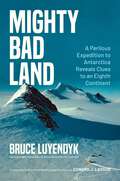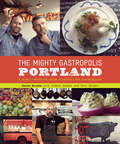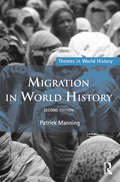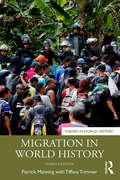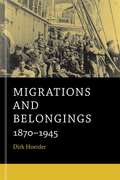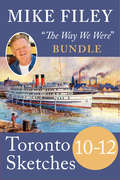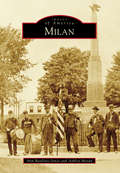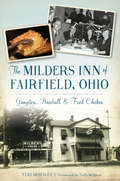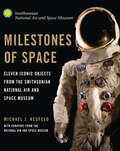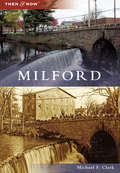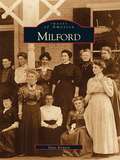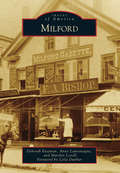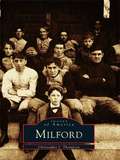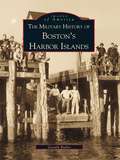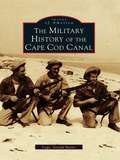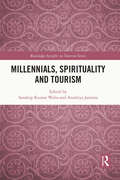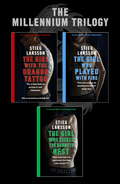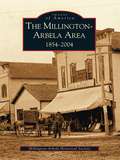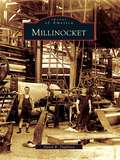- Table View
- List View
Midwest Made: Big, Bold Baking from the Heartland
by Shauna SeverA Love Letter to America's Heartland, the Great Midwest When it comes to defining what we know as all-American baking, everything from Bundt cakes to brownies have roots that can be traced to the great Midwest. German, Scandinavian, Polish, French, and Italian immigrant families baked their way to the American Midwest, instilling in it pies, breads, cookies, and pastries that manage to feel distinctly home-grown. After more than a decade of living in California, author Shauna Sever rediscovered the storied, simple pleasures of home baking in her Midwestern kitchen. This unique collection of more than 125 recipes includes refreshed favorites and new treats:Rhubarb and Raspberry Swedish Flop Danish KringleSecret-Ingredient Cherry Slab Pie German LebkuchenScotch-a-Roos Smoky Cheddar-Crusted Cornish Pasties. . . and more, which will make any kitchen feel like a Midwestern home.
Midwest Medicinal Plants: Identify, Harvest, and Use 109 Wild Herbs for Health and Wellness
by Lisa M. Rose“This comprehensive, accessible, full-color guide includes plant profiles, step-by-step instructions for essential herbal remedies and seasonal foraging tips.” —Natural Awakenings Chicago In Midwest Medicinal Plants, Lisa Rose is your trusted guide to finding, identifying, harvesting, and using 120 of the region’s most powerful wild plants. You’ll learn how to safely and ethically forage and how to use wild plants in herbal medicines including teas, tinctures, and salves. Plant profiles include clear, color photographs, identification tips, medicinal uses and herbal preparations, and harvesting suggestions. Lists of what to forage for each season makes the guide useful year-round. Thorough, comprehensive, and safe, this is a must-have for foragers, naturalists, and herbalists in Illinois, Indiana, Iowa, Kansas, Michigan, Minnesota, Missouri, Nebraska, North Dakota, South Dakota, Ohio, and Wisconsin.
The Midwest Survival Guide: How We Talk, Love, Work, Drink, and Eat . . . Everything with Ranch
by Charlie BerensEverything you need to know to survive in the greatest place on EarthHave you ever had a goodbye lasting more than four hours? Do you lack the emotional capacity to say “I love you” so you just tell your loved ones to “watch out for deer”? Have you apologized to a stranger because she stepped on your foot? If you answered yes to any of these questions, there’s a good chance you’re a Midwesterner—or a Midwesterner at heart. Even if you answered no, you probably know someone who held the door for you from two football fields away. He likely waved at you and said, “Hey there,” like you organized the church bar crawl together. That was a Midwesterner in the wild. We understand that your interaction was strange—but it’s likely to get stranger. Don’t wait until they stick their head in your second-floor window to invite you over for a perch fry because they climbed on your roof to clean your gutters. There’s no need to pull the pepper spray; this species is helpful by nature. And the relationship could be very symbiotic—but only if you let it happen. And that’s where this book comes into play.Inspired by my comedy tours across the Midwest and life growing up in Wisconsin, this book is an exploration into my favorite region on Earth. Some may think the Midwest is just a bunch of bland flyover states filled with less diversity than a Monsanto monoculture. But scratch that surface with your buck knife and you’ll find rich cultures and traditions proving we’re more than just fifty shades of milk. So whether you’re a born-and-bred Midwesterner looking to sharpen your skill at apologies or a costal elite visiting the in-laws for the holidays, this book will help you navigate the Midwest, with everything from the best flannel looks to dating and mating rituals (yes, casserole is involved) to climbing the corporate corn silo to how to handle a four-way stop—and every backyard brat fry in between. And for those of you who don’t like reading, don’t worry—we’ve got pictures! Toss in illustrations, sidebars, quizzes, and jokes worthy of a supper club stall and The Midwest Survival Guide is just the walleye-deep look into this distinctive, beautiful, and bizarre American culture you’ve been looking for.
Mighty Bad Land: A Perilous Expedition to Antarctica Reveals Clues to an Eighth Continent
by Bruce LuyendykA tale of grit and real teamwork in the wilds of Antarctica when the hunger for knowledge reigns supreme.Anything can happen in a pure wilderness experienced by few humans—a place where unseen menace waits everywhere. This story is an unembellished account of a scientist and his team exploring the last place on Earth. But, unlike most recent books on Antarctica, the reader becomes embedded with geologist Bruce Luyendyk&’s team. They share the challenges, companionship, failures, bravery, and success brought to light from scientific research pursued in an unforgiving place, Marie Byrd Land, or Mighty Bad Land. The geologists make surprising discoveries. Luyendyk realizes that vast submarine plateaus in the southwest Pacific are continental pieces that broke away from the Marie Byrd Land sector of Gondwana. He coined &“Zealandia&” to describe this newly recognized submerged continent. Only the tops of its mountains poke above sea level to host the nation of New Zealand. This stunning revelation of a submerged eighth continent promises economic and geopolitical consequences reverberating into the twenty-first century. The story occurs in the 1990s and fills a gap in the timeline of Antarctic exploration between the Heroic Age, the age of military exploration, and before the modern era of science. Danger is exponentially greater, isolation a constant threat without GPS, satellite phones, and the internet. As the expedition&’s leader, Luyendyk stands up to his demons that surface under the extreme duress of his experience, like nearly losing two team members.
The Mighty Gastropolis: A Journey Through the Center of America's New Food Revolution
by Karen Brooks Gideon Bosker Teri Gelber“Explore[s] the ingenious outsider cooks, the obsessive impulses, and the raging gustatory dishes behind America’s newest food capitol.” —Mike Thelin, commentator for Unique Eats and co-founder of Feast PortlandThe Mighty Gastropolis goes deep behind the scenes to explore the kitchens, personal lives, and mindsets of Portland’s celebrated cooks to chronicle, with humor and panache, a people’s army of maverick chefs, artisans, obsessives, farmers, food carters, and plucky pioneers who have created a risk-taking, no rules food town unlike any other: one that is exporting its culinary ethos, innovations, and sensibilities to America’s gastronomic power zones in New York, LA, Chicago, and countless other cities that are coming under its spell: a spell and culinary imagination that, according to Bon Appétit Restaurant and Drinks Editor, Andrew Knowlton, emanates from “a city thriving with creativity, passion, and an anything-goes attitude for all things edible.” In this book, you will learn, ingredient by ingredient, experiment by experiment, dish by dish, how Portland’s culinary cognoscenti have re-imagined and reconfigured restaurant culture for modern times and established a new paradigm for how to succeed in the fiercely competitive, no-chops-barred worlds of both hi- and lo-fi dining. The result, as Thomas Lauderdale, founder of Pink Martini, explains, “is a hilarious, heart-warming, punk-rock portrait of a daringly creative Mecca showing the rest of America a better way to eat—and live.” This is a landmark contribution to the literature of food. And, perhaps best of all, the book’s recipes are roadmaps to rarified states of gastro-nirvana.
Migration in World History
by Patrick ManningThis fully revised and updated second edition of Migration in World History traces the connections among regions brought about by the movement of people, diseases, crops, technology and ideas. Drawing on examples from a wide range of geographical regions and thematic areas, noted world historian Patrick Manning guides the reader through: the earliest human migrations, including the earliest hominids, their development and spread, and the controversy surrounding the rise of homo sapiens the rise and spread of major language groups (illustrated with original maps) an examination of civilizations, farmers and pastoralists from 3000 BCE to 500 CE trade patterns including the early Silk Road and maritime trade in the Mediterranean and Indian Ocean the effect of migration on empire and industry between 1700 and 1900 the resurgence of migration in the later twentieth century, including movement to cities, refugees and diasporas the various leading theories and debates surrounding the subject of migration.
Migration in World History (Themes in World History)
by Patrick Manning Tiffany TrimmerIn this third edition of Migration in World History, Patrick Manning presents an expanded and newly coherent view of migratory processes, conveying new research and interpretation. The engaging narrative shows the continuity of migratory processes from the time of foragers who settled the earth to farmers opening new fields and merchants linking purchasers everywhere. In the last thousand years, accumulation of wealth brought capitalism, industry, and the travels of free and slave migrants. In a contest of civilizational hierarchy and movements of emancipation, nations arose to replace empires, although conflicts within nations expelled refugees. The future of migration is now a serious concern. The new edition includes: An introduction to the migration theories that explain the shifting patterns of migration in early and recent times Quantification of changes in migration, including international migration, domestic urbanization, and growing refugee movements A new chapter tracing twenty-first-century migration and population from 2000 to 2050, showing how migrants escaping climate change will steadily outnumber refugees from other social conflicts While migration is often stressful, it contributes to diversity, exchanges, new perspectives, and innovations. This comprehensive and up-to-date view of migration will stimulate readers with interests in many fields.
Migrations and Belongings: 1870-1945
by Dirk HoerderToward the end of the nineteenth century, new railroads, ports, and steamships enabled people to travel faster and in greater numbers than ever before. Migrations and Belongings traces burgeoning population movements across several continents from 1870 to the end of World War II. This study explains the complex variables involved in global migrations and the processes of acculturation by which "belonging" takes shape. Dirk Hoerder emphasizes the migration systems that emerge when population clusters move between regions over long periods of time. Eschewing a Eurocentric perspective, he identifies five major systems in different parts of the world where men and women left areas with labor surpluses and swelled regions of urban and industrial growth. These include African slave migration from the 1440s to the 1870s; migration of free and indentured men and women across Asia; Russo-Siberian migration across parts of Asia, North America, and Europe; a North China-Manchurian migration; and an Atlantic system connecting Europe and the Americas. Migrations within and among regions and empires both encouraged population mixing and produced new social stratifications. Questioning the "container" view of states, Hoerder considers instead the dynamic effects of departure, transit, and arrival. Migration, he shows, is both a critique of unsatisfactory conditions in one society and a contribution of human capital to another.
Mike Filey's Toronto Sketches, Books 10–12
by Mike FileyMike Filey brings the stories of Toronto, its people and places, to life. Mike Filey’s column “The Way We Were” first appeared in the Toronto Sunday Sun not long after the paper’s first edition hit newsstands on September 16, 1973. Now, almost four decades later, Filey’s column has had an uninterrupted stretch as one of the newspaper’s most widely read features. In 1992, a number of his columns were reprinted in Toronto Sketches: “The Way We Were.” Since then another eleven volumes have been published to great success, with over 5,000 copies sold. Includes: - Toronto Sketches 10 - Toronto Sketches 11 - Toronto Sketches 12
Milan (Images of America)
by Martha A. ChurchillJohn Marvin started the town of Milan in 1831 by placing a two-story log building beside a dirt Native American trail. The Saline River was just a few steps away. About that time, Native Americans were either moving to reservations west of Michigan or blending in with the melting pot. Milan and its neighboring communities, such as Azalia, Paint Creek, and Mooreville, grew quickly with the influx of settlers from out East. Shoemakers arrived, along with grocers, flour mills, and even cheese factories. The Milan Area Historical Society holds a treasure trove of photographs, maps, and drawings showing the heritage in and around Milan. One of its citizens was nationally known for his scale inventions. Other citizens achieved notoriety for pulling off a stock scam in New York promoting the Electric Sugar Refining Company. Two magnificent homes near Milan were built with "sugar money."
Milan (Images of America)
by Ashley Moran Ann Basilone-JonesMilan is located in an area of land known as the Fire Lands, just south of Lake Erie. The first settlement, a Moravian mission called New Salem, did not last long, and permanent settlement came with Ebenezer Merry in 1816. Within 20 years, the citizens of Milan were planning a project that would change the face of the village forever. A group of businessmen banded together and formed the Milan Canal Company, eventually being incorporated by the State of Ohio to help fund the Milan Canal. The economic success that the canal brought resulted in a surge of architecture and wealth in the area. Samuel Edison, a shingle-maker by trade, brought his family here from Canada to gain a piece of the prosperity. During the peak year of 1847, Thomas Alva Edison was born in his home in Milan, where the family remained for seven years.
The Milders Inn of Fairfield, Ohio: Gangsters, Baseball & Fried Chicken (American Palate)
by Teri Horsley Tully MildersMom Milders's "Best in the Middle West" fried chicken drew crowds of regular and famous folk alike to her Fairfield establishment for decades until it closed after World War II. Notorious gangster John Dillinger stopped in for a bite while on the lam, but Mom made sure he removed his hat inside the building just like everyone else. Hall of Famer Ernie Lombardi of the Cincinnati Reds was a regular, mingling with fans at the inn. Today, the family still serves up the original fried chicken recipe every week at Ryan's Tavern in Hamilton. Author Teri Horsley explores the nostalgia and beloved recipes of the former inn that served up delectable home cooking with a side of history.
Milestones of Space: Eleven Iconic Objects for the Smithsonian National Air and Space Museum
by Michael J. NeufeldA history of exploration through eleven objects from the Air and Space Museum: “Takes you behind the scenes with firsthand stories and rare photos.” —William F. Readdy, former NASA astronaut and Space Shuttle commanderThroughout human history, across cultures and landscapes, countless individuals have gazed with wonder in the same direction: upward. Getting to space was no easy task, and our quest to further explore the universe, to understand the impossibly vast heavens, continues.In Milestones of Space, Michael Neufeld and select curators of the Smithsonian National Air and Space Museum present a gorgeous photographic celebration of some of the most groundbreaking artifacts that played key parts in giving humanity its first steps into the cosmos. Focusing on the most iconic objects and technology—such as Friendship 7, the Lunar Module 2, Neil Armstrong’s Lunar Suit, the Hubble Space Telescope, and Space Shuttle Discovery—this book extensively profiles eleven of the NASM’s most important breakthroughs in space technology.The NASM curators feature each object in incredible detail with compelling timelines, sidebars and captions, and over 150 archival images that provide new and little-known insights into their development and historical context. We are still a long way from grasping our universe—but for now, Milestones of Space magnificently commemorates the individuals and inventions that have taken us this far.
Milford (Then and Now)
by Michael F. ClarkOn August 22, 1914, Milford, Connecticut, celebrated its 275th anniversary. An estimated crowd of 20,000 celebrated on the Milford Green alongside open-air horseless buggies. The celebration started at sunrise with a cannon salute and the sounding of church bells and factory whistles. Milford just recently celebrated its 375th anniversary.
Milford (Images of America)
by Dave KentonMilford, Delaware, is a unique town in the heart of southern Delaware with one foot in Kent County and the other in Sussex County. Location is a major thread of success for Milford-it is within 100 miles of Washington, D.C., Philadelphia, and Baltimore and only a short 25-minute drive to the Delaware beaches. Greater Milford offers a rare blend of relaxed rural life and progressive, modern convenience. The historic district, riverfront greenway, and civic-minded residents lend a charm to Milford not found in every small town.Visit Milford of days gone by and glimpse the early English settlers who would shape tracts of land into a promising town. See how the area once called "Saw Mill Range" evolved from primitive woodlands into the commercial center known as Milford. Distinguish all the enterprising leaders who made Milford a thriving town with their innovations like canning and fruit drying and shipbuilding. The Mispillion River, Marshall's Mill, Milford Chronicle, Calvary Church, Slaughter Beach Hotel, Cedar Neck, the Levin Crapper Mansion built in 1763, Purity Row, along with the people, businesses, and events presented in this photographic celebration showcase what makes Milford an exceptional place to live and prosper.
Milford
by Anne Lamontagne Marilyn Lovell Leila Dunbar Deborah EastmanIn 1670, Puritan pioneers colonized the Nipmuck Indian territory that would develop into the town of Milford, officially incorporated in 1780. Its advantageous location between the Mill and Charles Rivers created a convenient commercial center. By 1850, major railway lines traversed routes to Boston and New York, enabling Milford to develop the largest boot-and-shoe industry in the nation. When pink granite was discovered in the late 1800s, Milford's stone business boomed. The quarries and factories attracted skilled European immigrants who made the area home. The community grew, establishing cultural commitments to education, music, and athletics. Dr. Joseph E. Murray, winner of the Nobel Prize in Medicine, and Col. Alexander Scammell, a hero of the Revolutionary War, were both sons of Milford. Today, Milford continues to prosper with successful businesses like Consigli Construction, Archer Rubber, and Waters Corporation. The town is also noted for the Milford Regional Medical Center, which ranks as a premier facility in New England.
Milford
by Christopher J. ThompsonSettled on the edge of the Monadnock region, Milford is a growing community that has managed to maintain its small-town charm. Residents have taken great pride in their community through the years. In 2002, the National Trust for Historic Preservation awarded Milford one of only five national Great American Main Street Awards for the revitalization of the downtown area, an award that would not have been possible without much volunteer and team effort.With pictures and words, Milford looks back at the people, places, and events that have molded the community into the appealing one it is today. It contains views of places that have been gone for decades: the White Elephant shop, the Milford Inn, French & Heald furiture company, and the many working granite quarries, which in their time earned Milford the nickname the "granite town of the Granite State." Well represented are the historic downtown area and the common, known also as "the oval" since it bore that shape in the 1800s.
Military History of Boston's Harbor Islands, The (Images of America)
by Gerald ButlerThis accurate pictorial history will acquaint the reader with the seacoast defenses of Boston Harbor. Fortified since the the 1600s, seacoast defenses provided important protection for the new seaport. By the Civil War, strong granite fortresses guarded the seaward approaches to the Port of Boston. Later, powerful long-range guns and mortars protected the seaport. During World War II, the most sophisticated and powerful guns existing were installed. These guns used the first computers and radar systems developed for the military for target acquisition and tracking. In The Military History of Boston's Harbor Islands, great care has been taken to identify harbor defense systems at all of the harbor islands, mainland forts, and the observation and radar towers from Nahant to Scituate. The book identifies and explains the long-abandoned granite and concrete monoliths of Boston Harbor. The Military History of Boston's Harbor Islands brieflydescribes Edgar Allan Poe's tour of duty in Boston Harbor, the impact that Col. Sylvanus Thayer had on Boston's seacoast fortifications, and many mysterious structures at the harbor forts.
Military History of the Cape Cod Canal, The (Images of America)
by Capt. Gerald ButlerDuring World War II, with Allied merchant and navy ships under the threat of German U-boats, the eastern seaboard was on high alert. The Cape Cod Canal, a vital waterway for commercial and military traffic, underwent a period of strict control, occupation, and defense. This pictorial history documents the activity during that time and the extensive array of weaponry and manpower brought to bear in coastal defense.In The Military History of the Cape Cod Canal, the abandoned foundations at Sagamore Hill and throughout most of Buzzards Bay are explored, as well as the weapons, devices, and personnel assigned to ensure the canal's integrity throughout the war. Although the responsibilities of the U.S. Army's Coast Artillery are a focal point, the actions of the U.S. Navy, the U.S. Coast Guard, and the air arms of all the military services during World War II are also included. The Military History of the Cape Cod Canal documents the mishaps, collisions, and war-damaged ships in and near the canal, as well as the joint military protection forces and plans in effect during World War II.
Millennials, Spirituality and Tourism (Routledge Insights in Tourism Series)
by Sandeep Kumar Walia Aruditya JasrotiaThis book offers a conversant and comprehensive overview of the themes and concepts in spiritual tourism and Millennial tourists. Providing interdisciplinary insights from leading international researchers and academicians, this makes a critical contribution to the knowledge around spiritual tourism. Organized into four parts, the edited book provides modern and cutting-edge perspectives on important topics like linkages between spirituality and tourism, the predicament of spirituality in tourism among Millennials, anthropological views on spirituality, the work-life-balance, marketing of spiritual tourism destinations and the issues, threats and prospects of spiritual tourism in the emerging era. Part I introduces core concepts, theories on spiritual tourism and links it with the Millennial world. Part II explores the inclinations of millennials towards spirituality and their travel motivations, experiences, behaviours with special reference to spirituality. In Part III, on holistic tourism, the role of digitization in spiritual tourism adoption, marketing and management perspectives with special reference to Millennials are discussed. Part IV examines the issues, threats, policies and practices linked with spiritual tourism. This part also aims to explore the future challenges, opportunities for spiritual tourism development and to propose research-based solutions. Overall, the book will be a suitable means of getting insight into the minds of the diverse, experimental and open-minded generation of millennials. This book will fill the gap of research on spiritual tourism. As an edited book, it will add on new research and knowledge base with high quality contributions from researchers and practitioners interested in tourism management, hospitality management, business studies regional development and destination management.
The Millennium Trilogy
by Stieg LarssonDiscover the books that changed the way the world reads crime - Stieg Larsson's phenomenal global blockbuster, the Millennium TrilogyThe Girl with the Dragon Tattoo: Forty years ago, Harriet Vanger disappeared from a family gathering on the island owned by the powerful Vanger clan. Her uncle employs disgraced journalist Mikael Blomkvist and tattooed hacker Lisbeth Salander to investigate. When the pair link Harriet's disappearance to a number of grotesque murders, they begin to unravel a dark family history... The Girl Who Played With Fire: Lisbeth Salander is now a wanted woman, on the run from the police. Mikael Blomkvist, editor-in-chief of Millennium magazine, is trying to prove her innocence. Yet Salander is more avenging angel than helpless victim. She may be an expert at staying out of sight - but she has ways of tracking down her most elusive enemies. The Girl Who Kicked the Hornets' Nest: Salander is plotting her final revenge - against the man who tried to kill her, and against the government institutions that very nearly destroyed her life. With the help of journalist Mikael Blomkvist and his researchers at Millennium magazine, Salander is ready to fight to the end.Stieg Larsson's phenomenal trilogy is continued in The Girl in the Spider's Web and The Girl Who Takes an Eye for an Eye by David Lagercrantz.
The Millennium Trilogy
by Stieg LarssonDiscover the books that changed the way the world reads crime - Stieg Larsson's phenomenal global blockbuster, the Millennium TrilogyThe Girl with the Dragon Tattoo: Forty years ago, Harriet Vanger disappeared from a family gathering on the island owned by the powerful Vanger clan. Her uncle employs disgraced journalist Mikael Blomkvist and tattooed hacker Lisbeth Salander to investigate. When the pair link Harriet's disappearance to a number of grotesque murders, they begin to unravel a dark family history... The Girl Who Played With Fire: Lisbeth Salander is now a wanted woman, on the run from the police. Mikael Blomkvist, editor-in-chief of Millennium magazine, is trying to prove her innocence. Yet Salander is more avenging angel than helpless victim. She may be an expert at staying out of sight - but she has ways of tracking down her most elusive enemies. The Girl Who Kicked the Hornets' Nest: Salander is plotting her final revenge - against the man who tried to kill her, and against the government institutions that very nearly destroyed her life. With the help of journalist Mikael Blomkvist and his researchers at Millennium magazine, Salander is ready to fight to the end.Stieg Larsson's phenomenal trilogy is continued in The Girl in the Spider's Web and The Girl Who Takes an Eye for an Eye by David Lagercrantz.
Miller Place (Images of America)
by Mindy Kronenberg Edna Davis Giffen Candace LindemannSituated on top of the bluffs facing Long Island Sound, Miller Place is a treasure trove of Long Island history. With the arrival of the railroad in the late 1800s, the beaches became a popular holiday and summer camp destination. Initially boardinghouses served vacationers until proprietors opened inns and resorts. Throughout the 20th century, Miller Place attracted vacationers from nearby New York City, including Paul Newman, Arthur Miller, and a young Anjelica Huston. Drawn by its bucolic setting, friendly atmosphere, and career opportunities at nearby Stony Brook University and Hospital, commuters in the 1970s and 1980s expanded and updated vacation homes and developed new lots. As the population grew, the civic-minded residents formed their own high school, fire department, historical society, civic association, and the North Shore Youth Council. Miller Place's historic homes, natural spaces, and strong public schools make the hamlet a desirable place to raise a family.
Millington-Arbela Area 1854-2004, The: 1854-2004 (Images of America)
by Millington-Arbela Historical SocietySince settlers first arrived in the mid-1800s, the townships of Millington and Arbela have developed into strong communities with deep cultural roots. This informative book documents the Millington-Arbela area's growth and progress over the course of 150 years, exploring founding families, village growth, religion, business, and education through rare archival photographs and postcards. In celebration of the region's sesquicentennial anniversary, the Millington-Arbela Historical Society takes readers on a detailed visual tour of the area's rich history, revealing the remarkable people, places, and events that have shaped the townships as they are known today.
Millinocket
by David R. DupliseaThe town of Millinocket rests at the junction where the West Branch of the Penobscot River and the Millinocket Stream converge. In 1898, settlers arrived in the area and carved a town out of the wilderness, constructing the Great Northern Paper Company, the largest paper mill in the world at that time. Utilizing the waterways, lumbermen floated the logs downriver to feed the mill and export paper around the globe. The town and mill sprang up practically overnight, built at a fevered pace to keep up with the paper demand, and gave Millinocket the nickname "Magic City in Maine's Wilderness." Today Millinocket is the closest town to the famous Baxter State Park and Maine's highest peak, Mount Katahdin. As the gateway to the Allagash region, Millinocket draws tourists year-round with its numerous outdoor activities.



